ANALYSIS AND COMMENTS
BALANCE OF PAYMENTS
In original current price terms, the March quarter 2019 current account deficit was $1,096m, a fall of $5,433m on the December quarter 2018 deficit. In original current price terms, the balance on goods and services was a net surplus of $15,942m, primary income was a net deficit of $16,277m and secondary income was a net deficit of $761m.
In original current price terms, the March quarter 2019 capital and financial account surplus was $812m, a fall of $7,708m on the December quarter 2018 surplus. In original current price terms, the capital account was a net deficit of $190m and the financial account was a net surplus of $1,002m.
The contributors to the current account balances, in original terms at current prices, are shown in the following table.
BALANCE OF PAYMENTS, Summary(a): Original |
|
 |  |  |  |  | Mar 2018 | Jun 2018 | Sep 2018 | Dec 2018 | Mar 2019 |
 |  |  |  |  | $m | $m | $m | $m | $m |
|
| CURRENT ACCOUNT | -9 167 | -10 599 | -12 507 | -6 529 | -1 096 |
 | Goods and services | 5 854 | 3 474 | 5 558 | 8 250 | 15 942 |
 |  | Credits | 102 658 | 105 581 | 111 914 | 117 974 | 116 411 |
 |  | Debits | -96 804 | -102 107 | -106 356 | -109 724 | -100 469 |
 |  |  | Goods | 4 217 | 6 059 | 8 680 | 9 178 | 13 636 |
 |  |  |  | Credits | 78 381 | 84 557 | 89 043 | 93 361 | 90 114 |
 |  |  |  | Debits | -74 164 | -78 498 | -80 363 | -84 183 | -76 478 |
 |  |  | Services | 1 637 | -2 585 | -3 122 | -928 | 2 306 |
 |  |  |  | Credits | 24 277 | 21 024 | 22 871 | 24 613 | 26 297 |
 |  |  |  | Debits | -22 640 | -23 609 | -25 993 | -25 541 | -23 991 |
 | Primary income | -14 624 | -13 560 | -17 769 | -14 852 | -16 277 |
 |  | Credits | 14 687 | 16 100 | 16 446 | 17 721 | 18 269 |
 |  | Debits | -29 311 | -29 660 | -34 215 | -32 573 | -34 546 |
 | Secondary income | -397 | -513 | -296 | 73 | -761 |
 |  | Credits | 2 253 | 2 327 | 2 334 | 2 363 | 2 328 |
 |  | Debits | -2 650 | -2 840 | -2 630 | -2 290 | -3 089 |
| CAPITAL AND FINANCIAL ACCOUNT | 9 753 | 13 559 | 14 004 | 8 520 | 812 |
 | Capital account | -20 | -134 | -175 | -162 | -190 |
 |  | Acquisitions/disposals of non-produced non-financial assets | 123 | 32 | 3 | 33 | 13 |
 |  |  | Credits | 125 | 80 | 3 | 63 | 14 |
 |  |  | Debits | -2 | -48 | - | -30 | -1 |
 |  | Capital transfers | -143 | -166 | -178 | -195 | -203 |
 |  |  | Credits | - | - | - | - | - |
 |  |  | Debits | -143 | -166 | -178 | -195 | -203 |
 | Financial account | 9 773 | 13 693 | 14 179 | 8 682 | 1 002 |
 |  | Direct investment | 14 616 | 26 713 | 4 314 | 33 204 | 807 |
 |  |  | Assets | -494 | -7 675 | -10 042 | 15 736 | -6 690 |
 |  |  | Liabilities | 15 110 | 34 388 | 14 356 | 17 468 | 7 497 |
 |  | Portfolio investment | 6 988 | 803 | -16 108 | -7 561 | -20 078 |
 |  |  | Assets | -30 572 | -21 897 | -3 988 | -23 713 | -9 631 |
 |  |  | Liabilities | 37 560 | 22 700 | -12 121 | 16 151 | -10 447 |
 |  | Financial derivatives | 5 318 | -4 845 | -837 | -5 549 | -776 |
 |  |  | Assets | 20 841 | 20 928 | 29 731 | 10 375 | 18 084 |
 |  |  | Liabilities | -15 523 | -25 773 | -30 568 | -15 924 | -18 860 |
 |  | Other investment | -27 572 | -10 266 | 25 495 | -12 736 | 22 896 |
 |  |  | Assets | -26 746 | -2 844 | 27 927 | -4 793 | 18 254 |
 |  |  | Liabilities | -825 | -7 422 | -2 432 | -7 943 | 4 642 |
 |  | Reserve assets | 10 423 | 1 289 | 1 315 | 1 324 | -1 846 |
| NET ERRORS AND OMISSIONS | -586 | -2 960 | -1 498 | -1 991 | 284 |
|
| - nil or rounded to zero (including null cells) |
| (a) For sign conventions, see paragraphs 15-17 of the Explanatory Notes. |
In seasonally adjusted current price terms, the March quarter 2019 current account deficit was $2,900m, a fall of $3,425m on the December quarter 2018 deficit.
In trend current price terms, the March quarter 2019 current account deficit was $2,006m, a fall of $4,190m on the December quarter 2018 deficit.
The contributors to the current account balance, in seasonally adjusted and trend terms at current prices, are shown in the following table.
BALANCE ON CURRENT ACCOUNT IN CURRENT PRICES - March Quarter 2019 |
|
 |  |  |  | Change in: |
 |  |  | Current prices | Current prices | Current prices |
 |  |  | $m | $m | % |
Seasonally Adjusted |
|
| Balance on current account | -2 900 | 3 425 | 54.2 |
 | Balance on goods and services | 13 594 | 4 753 | 53.8 |
 |  | Net goods | 14 332 | 4 200 | 41.5 |
 |  | Net services | -738 | 553 | 42.8 |
 | Net primary income | -15 984 | -1 192 | -8.1 |
 | Net secondary income | -510 | -136 | -36.4 |
Trend |
|
| Balance on current account | -2 006 | 4 190 | 67.6 |
 | Balance on goods and services | 13 846 | 4 020 | 40.9 |
 |  | Net goods | 14 793 | 3 866 | 35.4 |
 |  | Net services | -947 | 154 | 14.0 |
 | Net primary income | -15 384 | 220 | 1.4 |
 | Net secondary income | -467 | -48 | -11.5 |
|
TERMS OF TRADE(footnote 1)
Australia's seasonally adjusted terms of trade on net goods and services for the March quarter 2019 rose 3.1% to 110.0, with an increase of 2.7% in the implicit price deflator (IPD) for goods and services credits and a decrease of 0.4% in the IPD for goods and services debits.
In trend terms, the terms of trade for net goods and services rose 3.2% to 110.4.
IMPLICIT PRICE DEFLATOR AND TERMS OF TRADE (a)
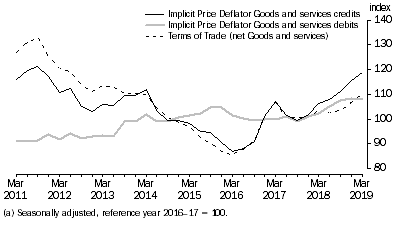
BALANCE ON GOODS AND SERVICES
In seasonally adjusted chain volume terms, the balance on goods and services was a surplus of $2,597m, a rise of $1,069m on the December quarter 2018 surplus of $1,527m.
The net surplus on goods rose $282m on the December quarter 2018 surplus of $1,760m. Goods credits rose $522m (1%) and goods debits rose $240m. The net surplus on services was a turnaround of $787m on the December quarter 2018 deficit of $232m.
The rise in the balance on goods and services surplus, in seasonally adjusted chain volume terms, is expected to contribute 0.2 percentage points to growth in the March quarter 2019 chain volume measure of GDP, assuming no significant revision to the GDP chain volume estimate for the December quarter 2018.
GOODS AND SERVICES, CHAIN VOLUME MEASURES (a)
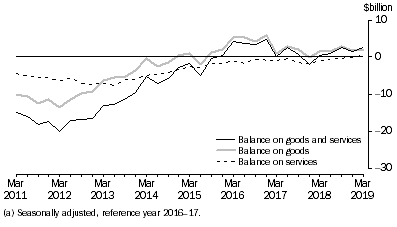
Goods
The trend estimate of net goods at current prices for the March quarter 2019 was a surplus of $14,793m, a rise of $3,866m on the December quarter 2018 surplus of $10,927m.
In seasonally adjusted terms at current prices, net goods was a surplus of $14,332m, a rise of $4,200m on the December quarter 2018 surplus of $10,132m.
GOODS, Price and volume analysis: Seasonally adjusted - March Quarter 2019 |
|
 | Change in: |
 | Current prices | Current prices | Chain volume measures(a) | Implicit price deflators(a)(b) |
 | $m | % | % | % |
|
| Exports | 3 695 | 4.1 | 0.7 | 3.4 |
| Rural goods | 816 | 7.0 | 6.5 | 0.5 |
| Non-rural goods | 1 098 | 1.5 | -2.5 | 4.1 |
| Net exports of goods under merchanting | -37 | -54.4 | -58.7 | 10.3 |
| Non-monetary gold | 1 818 | 48.4 | 39.2 | 6.6 |
| Imports | -505 | -0.6 | 0.3 | -0.9 |
| Consumption goods | 598 | 2.3 | 3.0 | -0.6 |
| Capital goods | 371 | 1.9 | 1.2 | 0.7 |
| Intermediate and other merchandise goods | -1 605 | -4.7 | -2.7 | -2.0 |
| Non-monetary gold | 131 | 10.9 | 3.8 | 6.8 |
|
| (a) Reference year 2016-17. |
| (b) Movements in indexes are based on data to four decimal places. |
GOODS CREDITS
The trend estimate of goods credits at current prices rose $3,962m (4%) to $95,299m in the March quarter 2019.
In seasonally adjusted terms at current prices, goods credits rose $3,695m (4%) to $94,548m, with volumes up 1% and prices up 3%.
Rural Goods
Exports of rural goods, in seasonally adjusted terms at current prices, rose $816m (7%) to $12,499m, with volumes up 6%.
The main components contributing to the rise were:
- meat and meat preparations, up $412m (12%), with volumes up 15% and prices down 2%
- other rural, up $323m (6%), with volumes up 3% and prices up 3%
- wool and sheepskins, up $139m (14%), with volumes up 15% and prices down 1%.
Partly offsetting these rises was cereal grains and cereal preparations, down $58m (3%), with volumes down 7% and prices up 4%.
Non-rural Goods
Exports of non-rural goods, in seasonally adjusted terms at current prices, rose $1,098m (1%) to $76,443m, with volumes down 3% and prices up 4%.
The main components contributing to the rise were:
- metal ores and minerals, up $1,692m (7%), with volumes down 5% and prices up 12%
- machinery, up $182m (7%), with volumes up 6% and prices up 1%
- other manufactures, up $126m (2%), with volumes up 2%.
Partly offsetting these rises were:
- other mineral fuels, down $360m (2%), with volumes down 1% and prices down 1%
- transport equipment, down $312m (21%), with volumes down 22% and prices up 1%
- metals (excl. non-monetary gold), down $130m (4%), with volumes down 6% and prices up 3%.
SELECTED MAJOR COMMODITIES, CURRENT PRICES (a)
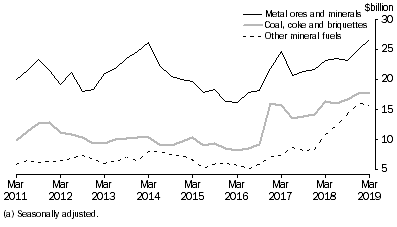 Net Exports of Goods Under Merchanting
Net Exports of Goods Under Merchanting
Net exports of goods under merchanting, in seasonally adjusted terms at current prices, fell $37m (54%) to $31m, with volumes down 59% and prices up 10%.
Non-monetary Gold
Exports of non-monetary gold, in original and seasonally adjusted terms at current prices, rose $1,818m (48%) to $5,575m, with volumes up 39% and prices up 7%.
GOODS DEBITS
The trend estimate of goods debits at current prices rose $95m to $80,505m in the March quarter 2019.
In seasonally adjusted terms at current prices, goods debits fell $505m (1%) to $80,216m, with prices down 1%.
Consumption Goods
Imports of consumption goods, in seasonally adjusted terms at current prices, rose $598m (2%) to $26,493m, with volumes up 3% and prices down 1%.
The main components contributing to the rise were:
- non-industrial transport equipment, up $439m (8%), with volumes up 8%
- consumption goods n.e.s., up $226m (3%), with volumes up 5% and prices down 2%
- food and beverages, mainly for consumption, up $108m (3%), with volumes up 3%.
Partly offsetting these rises was textiles, clothing and footwear, down $165m (4%), with volumes down 4%.
Capital Goods
Imports of capital goods, in seasonally adjusted terms at current prices, rose $371m (2%) to $19,828m, with volumes up 1% and prices up 1%.
The main components contributing to the rise were:
- industrial transport equipment n.e.s., up $764m (25%), with volumes up 25%
- machinery and industrial equipment, up $359m (6%), with volumes up 4% and prices up 2%
- capital goods n.e.s., up $161m (8%), with volumes up 8%.
Partly offsetting these rises were:
- civil aircraft and confidentialised items, down $566m (35%), with volumes down 36% and prices up 2%
- telecommunications equipment, down $252m (7%), with volumes down 7%.
Intermediate and Other Merchandise Goods
Imports of intermediate and other merchandise goods, in seasonally adjusted terms at current prices, fell $1,605m (5%) to $32,562m, with volumes down 3% and prices down 2%.
The main components contributing to the fall were:
- fuels and lubricants, down $1,389m (13%), with volumes down 7% and prices down 7%
- processed industrial supplies n.e.s., down $142m (1%), with volumes down 2%.
Non-monetary Gold
Imports of non-monetary gold, in original and seasonally adjusted terms at current prices, rose $131m (11%) to $1,333m, with volumes up 4% and prices up 7%.
SERVICES
The trend estimate of net services at current prices was a deficit of $947m, a fall of $154m on the December quarter 2018 deficit of $1,101m.
In seasonally adjusted terms at current prices, net services was a deficit of $738m, a fall of $553m on the December quarter 2018 deficit of $1,291m.
SERVICES, Price and volume analysis: Seasonally adjusted - March Quarter 2019 |
|
 | Change in: |
 | Current prices | Current prices | Chain volume measures(a) | Implicit price deflators(a)(b) |
 | $m | % | % | % |
|
| Exports | 544 | 2.3 | 2.0 | 0.3 |
| Manufacturing services on physical inputs owned by others | - | - | - | - |
| Maintenance and repair services n.i.e. | 1 | 7.1 | 7.0 | 0.2 |
| Transport | -8 | -0.4 | -0.1 | -0.4 |
| Travel | 369 | 2.4 | 1.9 | 0.4 |
| Other services | 180 | 2.8 | 2.7 | 0.2 |
| Imports | -9 | - | -1.4 | 1.4 |
| Manufacturing services on physical inputs owned by others | - | - | - | - |
| Maintenance and repair services n.i.e. | -19 | -8.5 | -9.9 | 1.5 |
| Transport | 21 | 0.5 | 1.3 | -0.8 |
| Travel | -56 | -0.4 | -2.5 | 2.1 |
| Other services | 44 | 0.6 | -1.0 | 1.6 |
|
| - nil or rounded to zero (including null cells) |
| (a) Reference year 2016-17. |
| (b) Movements in indexes are based on data to four decimal places. |
Services Credits
Services credits, in seasonally adjusted terms at current prices, rose $544m (2%) to $24,410m, with volumes up 2%.
The main components contributing to the rise were:
- travel, up $369m (2%), with volumes up 2%
- other services, up $180m (3%), with volumes up 3%.
In seasonally adjusted terms, tourism related services credits rose $346m (2%) to $16,736m.
Services Debits
Services debits, in seasonally adjusted terms at current prices, fell $9m to $25,148m, with volumes down 1% and prices up 1%.
The main component contributing to the fall was travel, down $56m, with volumes down 3% and prices up 2%.
Partly offsetting this fall was other services, up $44m (1%), with volumes down 1% and prices up 2%.
In seasonally adjusted terms, tourism related services debits rose $2m to $14,458m.
PRIMARY INCOME
The trend estimate of the net primary income deficit at current prices fell $220m to $15,384m in the March quarter 2019.
In seasonally adjusted terms at current prices, the net primary income deficit rose $1,192m to $15,984m in the March quarter 2019.
NET PRIMARY INCOME
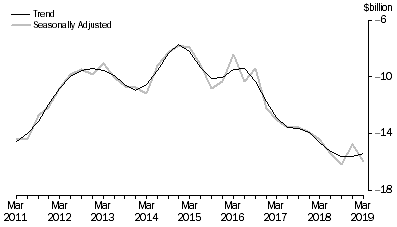
Primary Income Credits
Primary income credits, in seasonally adjusted terms at current prices, rose $1,234m (7%) to $18,611m. The main component of investment income contributing to the rise was direct investment assets, income on equity and investment fund shares, up $948m (16%).
Primary Income Debits
Primary income debits, in seasonally adjusted terms at current prices, rose $2,427m (8%) to $34,596m. The main component of investment income contributing to the rise was direct investment liabilities, income on equity and investment fund shares, up $2,493m (18%).
SECONDARY INCOME
The trend estimate of the net secondary income deficit at current prices rose $48m to $467m in the March quarter 2019.
In seasonally adjusted terms at current prices, the net secondary income deficit rose $136m to $510m in the March quarter 2019.
CAPITAL ACCOUNT
In original terms, the capital account deficit was $190m, an increase of $28m on the December quarter 2018 deficit of $162m. Capital account credits decreased $49m (78%) and capital account debits decreased $21m (9%) in the March quarter 2019.
FINANCIAL ACCOUNT
The balance on the financial account, in original terms, recorded a net inflow of $1.0b, which was driven by a net inflow of equity of $9.0b and a net outflow of debt of $8.0b.
The financial account surplus decreased $7.7b from $8.7b in the December quarter 2018, to $1.0b in the March quarter 2019.
Direct Investment
Direct investment recorded a net inflow of $0.8b in the March quarter 2019, a decrease of $32.4b on the net inflow of $33.2b in the December quarter 2018, where:
- direct investment liabilities recorded an inflow of $7.5b, a decrease of $10.0b (57%) on the inflow of $17.5b in the December quarter 2018
- direct investment assets recorded an outflow of $6.7b, a turnaround of $22.4b on the inflow of $15.7b in the December quarter 2018.
Portfolio Investment
Portfolio investment recorded a net outflow of $20.1b in the March quarter 2019, an increase of $12.5b on the net outflow of $7.6b in the December quarter 2018, where:
- equity and investment fund shares recorded a net inflow of $3.0b in the March quarter 2019, a turnaround of $43.6b on the net outflow of $40.6b in the December quarter 2018
- debt securities recorded a net outflow of $23.1b in the March quarter 2019, a turnaround of $56.1b on the net inflow of $33.0b in the December quarter 2018.
Financial Derivatives
Financial derivatives recorded a net outflow of $0.8b in the March quarter 2019, a decrease of $4.8b on the net outflow of $5.5b in the December quarter 2018.
Other Investment
Other investment recorded a net inflow of $22.9b in the March quarter 2019, a turnaround of $35.6b on the net outflow of $12.7b in the December quarter 2018. This was driven by a net inflow of $24.8b in loans and a net outflow of $6.4b in currency and deposits.
Reserve Assets
Reserve assets recorded an outflow of $1.8b in the March quarter 2019, a turnaround of $3.2b on the inflow of $1.3b in the December quarter 2018.
INTERNATIONAL INVESTMENT POSITION (IIP)
Australia's net IIP liability position was $966.1b at 31 March 2019, a decrease of $31.8b on the revised 31 December 2018 position of $998.0b. Australia's net foreign debt liability position increased $5.0b to $1,099.5b. Australia's net foreign equity asset position increased $36.8b to $133.3b at 31 March 2019.
The changes contributing to this result are shown in the following table.
INTERNATIONAL INVESTMENT POSITION, By Net Foreign Equity and Net Foreign Debt |
|
 |  |  | Changes in position reflecting |  |
 |  | Position at beginning of period | Transactions | Price changes | Exchange rate changes | Other adjustments | Position at end of period |
 |  | $m | $m | $m | $m | $m | $m |
|
| Net International Investment Position |  |  |  |  |  |  |
 | Sep 2018 | 955 663 | 14 179 | -11 129 | -4 335 | -4 548 | 949 830 |
 | Dec 2018 | 949 830 | 8 682 | 45 443 | -3 317 | -2 666 | 997 972 |
 | Mar 2019 | 997 972 | 1 002 | -31 121 | 3 583 | -5 290 | 966 146 |
| Net Foreign Equity |  |  |  |  |  |  |
 | Sep 2018 | -75 039 | 9 944 | -9 396 | -16 408 | -8 616 | -99 515 |
 | Dec 2018 | -99 515 | -11 345 | 36 563 | -17 424 | -4 825 | -96 546 |
 | Mar 2019 | -96 546 | 9 023 | -42 523 | 3 342 | -6 627 | -133 331 |
| Net Foreign Debt |  |  |  |  |  |  |
 | Sep 2018 | 1 030 703 | 4 235 | -1 733 | 12 073 | 4 068 | 1 049 345 |
 | Dec 2018 | 1 049 345 | 20 027 | 8 881 | 14 106 | 2 159 | 1 094 519 |
 | Mar 2019 | 1 094 519 | -8 021 | 11 401 | 241 | 1 337 | 1 099 476 |
|
SUPPLEMENTARY INFORMATION
CONDITIONS
The conditions in the global economy showed moderate growth in most of Australia’s major trading partner countries in the March quarter 2019. According to the Organisation for Economic Cooperation and Development (OECD)
(footnote 2) preliminary growth rates compared to last quarter in seasonally adjusted terms showed quarterly growth for China (1.4%), Indonesia (1.2%), the USA (0.8%), Spain (0.7%), the UK (0.5%), the Euro 28 (0.5%), Germany (0.4%), France (0.3%), Belgium (0.2%) and a fall for South Korea (-0.3%).
- foreign asset transactions were $18.2b in the March quarter 2019 compared to -$1.1b in the December quarter 2018
- foreign liability transactions were -$17.2b in the March quarter 2019 compared to $9.8b in the December quarter 2018.
The Australian share market, as measured by the MSCI global index
(footnote 3) increased 8.4% in the March quarter 2019, a turnaround from a decrease of 8.4% in the December quarter 2018. Increases were recorded in China (17.8%), Hong Kong (15.3%), Switzerland (13.5%), New Zealand (13.5%), the USA (13.3%), France (12.5%), Canada (12.2%), Germany (8.3%), the UK (7.8%), Brazil (7.5%), Japan (6.6%), India (6.0%), Singapore (5.4%) and Indonesia (3.3%). There was a decrease recorded for Malaysia (1.9%). A market price change of -$81.4b was recorded for foreign equity assets and $38.9b for foreign equity liabilities in the March quarter 2019.
According to Thomson Reuters
(footnote 4), the composite corporate benchmark yields decreased in the USA from 4.26% to 3.68%, Germany from 1.33% to 0.90%, the UK from 2.74% to 2.33% and Japan from 0.37% to 0.35% over the March quarter 2019. The long-term 10 year government bond yields decreased in Germany from 0.25% to -0.07%, the USA from 2.69% to 2.41%, the UK from 1.28% to 1.00% and Japan from 0.00% to -0.09% over the March quarter 2019. A market price change of -$2.2b was recorded for portfolio debt securities assets and $14.4b in portfolio debt securities liabilities in the March quarter 2019.
The Australian dollar saw mixed movement against major currencies in the March quarter 2019. The Australian dollar depreciated 2.53% against the UK pound sterling, 1.83% against the Chinese renminbi, 1.19% against the Indonesian rupiah, 1.01% against the Canadian dollar, 0.77% against the Indian rupee, 0.73% against the New Zealand dollar and 0.29% against the Singapore dollar. The Australian dollar appreciated 2.74% against the South Korean won, 2.14% against the Euro, 1.66% against the South African rand, 1.47% against the Swiss franc, 0.93% against the Hong Kong dollar, 0.72% against the Japanese yen, 0.52% against the Norwegian krone and 0.41% against the US dollar. The Trade Weighted Index (TWI)
(footnote 5) fell 0.33% to 60.5 in the March quarter 2019. These movements were reflected in exchange rate changes for foreign assets of $10.0b and foreign liabilities of -$6.4b in the March quarter 2019.
RELATIONSHIP BETWEEN IPD, EPI AND IPI(footnote 6)
In original terms, the IPD for total goods credits rose 3.8% and the chain Laspeyres price index for goods exports rose 4.2%. The Export Price Index (EPI)
(footnote 7) rose 4.5% during the March quarter 2019.
In original terms, the IPD for total goods debits fell 0.4% and the chain Laspeyres price index for goods imports fell 0.6%. The Import Price Index (IPI)
(footnote 7) fell 0.5% during the March quarter 2019.
Differences between the IPD and International Trade Price Indexes can arise due to a number of methodological factors including differences in pricing points, timing, coverage and weights.
GOODS AND SERVICES, Price comparison - March Quarter 2019 |
|
 |  | Change in: |
 |  | Seasonally adjusted | Original |
 |  | Implicit price deflators(a) | Implicit price deflators(a) | International trade price indexes(b) | Chain Laspeyres price indexes(a) |
 |  | % | % | % | % |
|
| Exports |  |  |  |  |
 | Goods | 3.4 | 3.8 | 4.5 | 4.2 |
 | Services | 0.3 | 0.3 | na | 0.3 |
| Imports |  |  |  |  |
 | Goods | -0.9 | -0.4 | -0.5 | -0.6 |
 | Services | 1.4 | 1.4 | na | 1.4 |
|
| na not available |
| (a) Reference year 2016-17 = 100. |
| (b) Source: International Trade Price Indexes, Australia (cat. no. 6457.0). |
IMPLICIT PRICE DEFLATORS AND INTERNATIONAL TRADE PRICE INDEXES
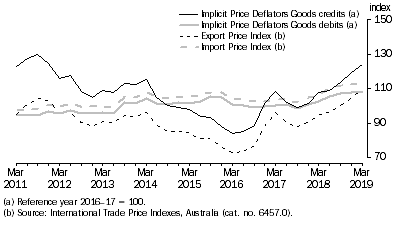
Commodity Price Indexes
The RBA Commodity Price Index (average monthly index) for rural commodities rose 1.6% between the December quarter 2018 and the March quarter 2019 while the EPI for rural goods rose 1.7%.
The RBA Commodity Price Index for non-rural commodities rose 4.4% between the December quarter 2018 and the March quarter 2019 while the EPI for non-rural goods (excluding non-monetary gold) rose 4.9%.
Differences between the RBA Commodity Price Index and ABS price measures are largely a consequence of methodological differences used in the construction of the respective indexes, including coverage of included commodities and timing of source data.
FOOTNOTES
1 In this commentary movements in indexes are based on data to four decimal places. <back
2 OECD Statistics Quarterly National Account, Organisation for Economic Cooperation and Development – Economic Department, viewed 23 May 2019. <back
3 MSCI Global Market Indexes 2018, Morgan Stanley Capital International, viewed 03 April 2019. <back
4 Thomson Reuters, viewed 03 April 2019. <back
5 Exchange Rates – Daily 2014 to Current, Reserve Bank of Australia - Statistical Tables, viewed 03 April 2019. <back
6 In this commentary movements in indexes are based on data to four decimal places. <back
7 Source: International Trade Price Indexes, Australia (cat. no. 6457.0). <back
 Print Page
Print Page
 Print All
Print All
 Quality Declaration
Quality Declaration